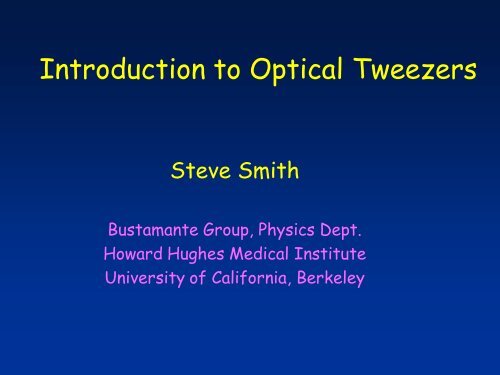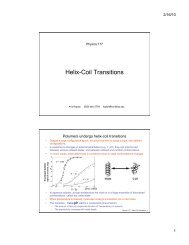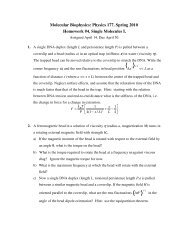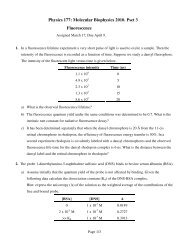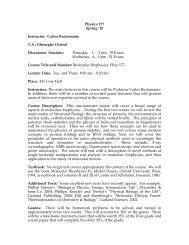Steve Smith - Bustamante Group - University of California, Berkeley
Steve Smith - Bustamante Group - University of California, Berkeley
Steve Smith - Bustamante Group - University of California, Berkeley
Create successful ePaper yourself
Turn your PDF publications into a flip-book with our unique Google optimized e-Paper software.
Introduction to Optical Tweezers<br />
<strong>Steve</strong> <strong>Smith</strong><br />
<strong>Bustamante</strong> <strong>Group</strong>, Physics Dept.<br />
Howard Hughes Medical Institute<br />
<strong>University</strong> <strong>of</strong> <strong>California</strong>, <strong>Berkeley</strong>
Comet tail<br />
Light transfers momentum to ma ter<br />
Light exerts force on matter<br />
James Clerk Maxwell<br />
1831-1879
Electromagnetic waves interact<br />
electric<br />
with electrons in matter<br />
DP = DU/c<br />
V<br />
e-<br />
E<br />
B<br />
F=eBV<br />
P = h k
Arthur Ashkin builds first optical trap<br />
Single-beam trap<br />
Dual-beam trap<br />
1970<br />
Axial<br />
escape
Photon meets refracting object<br />
Photon<br />
momentum<br />
P = h/l<br />
Pin<br />
F = dP/dt<br />
q<br />
Pout<br />
DP<br />
For every action there exists an equal but opposite reaction<br />
Sir Isaac Newton<br />
ashkin1.EXE
a stable single-beam trap<br />
Anti-scattering force:<br />
Forward momentum is<br />
increased by lens -focusing<br />
effect.<br />
ASHKIN2.EXE
Trap live<br />
bacteria<br />
Infrared trap supports life !<br />
Sort living<br />
cells<br />
Manipulate<br />
organelles<br />
inside cells<br />
Nature, 1987
Estimating Forces<br />
trap center<br />
Dx<br />
1. Assume a linear-spring restoring force<br />
2. Determine trap stiffness k<br />
3. Measure Dx relative to trap center<br />
F = k Dx
Calibrating trap stiffness<br />
(1) Stokes’ law<br />
(2) Corner frequency<br />
(3) Equipartition
Glass chamber<br />
Fluid drag test force<br />
Stokes’ law F = 6prhV but corrected for proximity to walls<br />
Distance<br />
detector<br />
Data<br />
acquisition<br />
Motorized<br />
Stage with<br />
encoder<br />
Glass<br />
Glass<br />
water
Brownian noise as test force<br />
Drag force<br />
= 6phr<br />
for a sphere<br />
Langevin equation:<br />
x<br />
F(<br />
t)<br />
kDx<br />
Dx<br />
2<br />
(<br />
f<br />
Fluctuating force<br />
= 0<br />
< F(t) F(t’) > = 2k BTd(t-t’)<br />
)<br />
<br />
<br />
4k<br />
B<br />
T<br />
2 2<br />
f f <br />
Lorentzian power spectrum<br />
c<br />
Trap force<br />
Corner<br />
frequency<br />
f c = 2p k /
Power (nm 2 /Hz)<br />
Power spectra<br />
f c=k/2p<br />
Frequency (Hz)<br />
1/f 2<br />
4k BT/k 2
Does not use drag coefficient, but rather ..<br />
Equipartition method<br />
integrate area under power curve to get <br />
k = k BT / <br />
However, you must have<br />
an accurate measure <strong>of</strong><br />
Dx at high bandwidth.<br />
This value is more<br />
easily taken in AFMs<br />
than optical traps.<br />
½ k = ½ k BT
Position clamp avoids problems with trap linearity
Measuring forces by analyzing<br />
momentum <strong>of</strong> the trap beam<br />
Light ray with power W<br />
dP/dt = nW/c<br />
input<br />
(nW/c) sin q<br />
F = -D dP/dt<br />
(nW/c) (1-cos q)<br />
q<br />
dP/dt<br />
output<br />
DdP/dt
Counter-propagating beams for<br />
LASER<br />
position<br />
detector<br />
narrow-angle trap<br />
pbs<br />
OBJ<br />
DNA<br />
pipette<br />
OBJ<br />
qwp<br />
liquid<br />
chamber<br />
position<br />
detector<br />
LASER
Narrow beams stay within NA <strong>of</strong> lenses<br />
liquid<br />
external<br />
force<br />
air<br />
detector
Light leaving trap obeys Abbe sine condition<br />
Front focus<br />
Focal length L<br />
Back focal plane<br />
X = n L sinq<br />
Objective lens<br />
BFP : where angle q is best<br />
represented by <strong>of</strong>fset x
How to measure light <strong>of</strong>fset?<br />
quadrant photodiode
versus PSD photodiode
+<br />
_ _<br />
+<br />
_ _<br />
_<br />
_<br />
QPD<br />
PSD<br />
+
PSD<br />
(position sensitive detector)<br />
Plate resistors<br />
separated by<br />
reverse-biased<br />
PIN photodiode<br />
In 1<br />
N<br />
Out 1<br />
P<br />
P<br />
Out 2<br />
N<br />
In 2<br />
opposite electrodes held at same potential<br />
no conduction unless there is light
PSD<br />
(position sensitive detector)<br />
Plate resistors<br />
separated by<br />
reverse-biased<br />
PIN photodiode<br />
In 1<br />
N<br />
Out 1<br />
P<br />
P<br />
Out 2<br />
Suppose we shine ray <strong>of</strong> light with intensity W i in exact center <strong>of</strong> detector:<br />
In 1 + In 2 = Out 1 + Out 2 = W i<br />
by charge conservation<br />
Out 1 = Out 2 = ½ W<br />
In 1 = In 2 = ½W<br />
by symmetry<br />
N<br />
In 2<br />
(sensitivity = 1)
PSD<br />
(position sensitive detector)<br />
In 1<br />
Now suppose the ray <strong>of</strong> is <strong>of</strong>f center.<br />
N<br />
Out 1<br />
P<br />
P<br />
Out 2<br />
N<br />
Out 1 + Out 2 = W = In 1 + In 2 still holds<br />
In 1 > In 2 and Out 1 > Out 2 due to resistance asymmetry<br />
Opposite electrodes held at equal potential so currents to those<br />
electrodes divide inversely to the distance <strong>of</strong> the spot from electrode.<br />
In 2
PSD<br />
(position sensitive detector)<br />
In 1<br />
N<br />
Out 1<br />
P<br />
P<br />
Out 2<br />
Multiple rays add their currents linearly to the electrodes,<br />
where each ray’s power adds W i current to the total sum.<br />
N<br />
In 2
PSD<br />
(position sensitive detector)<br />
In 1<br />
N<br />
Define x-y coordinates centered on detector<br />
it can be shown<br />
Out 1<br />
Out 2<br />
y<br />
P<br />
P<br />
N<br />
In 1 – In 2 = S W i x i / R D<br />
Out 1 – Out 2 = S W i y i / R D<br />
In 2<br />
where R D is the half-width (or “radius”) <strong>of</strong> the detector<br />
x
PSD<br />
(position sensitive detector)<br />
In 1<br />
N<br />
Out 1<br />
P<br />
P<br />
Out 2<br />
For arbitrary light distribution, centroid position given by difference <strong>of</strong> electrode currents<br />
where sum = In 1 + In 2 = Out 1 + Out 2 = S W i<br />
N<br />
X center= R D (In 1 –In 2) / sum<br />
Y center = R D (Out 1 – Out 2 ) / sum<br />
Sensitivity does not depend on spot size or shape<br />
In 2
PSD<br />
force<br />
sensor<br />
samples<br />
unfocused<br />
beam<br />
In 1<br />
N<br />
Out 1<br />
P<br />
P<br />
Out 2<br />
N<br />
S X = In 1 – In 2 = S W i x i / R D<br />
S Y = Out 1 – Out 2 = S W i y i / R D<br />
In 2
Detecting<br />
external<br />
force<br />
from<br />
changes<br />
in<br />
light<br />
momentum<br />
flux<br />
liquid<br />
n L<br />
air<br />
detector<br />
external<br />
force<br />
External force = light force = effect from all rays:<br />
Collector lens transforms exit angles into ray <strong>of</strong>fsets<br />
by Abbe Sine Condition: x i = L n L sin q i<br />
PSD sums over rays to give signal S X R D= SW i x i<br />
2L<br />
F x = dP/dt = (n L/c) SW i sin q i<br />
Then external transverse force is given by<br />
F X = S XR D /cL<br />
X
Momentum sensor calibration<br />
Calibrate signal to power ratio for PSDs / objectives with<br />
power meter and ruler.<br />
No test force is used.<br />
Calibration does not change with particle size, particle<br />
shape or laser power. Particle and trap are not being<br />
calibrated (don’t matter).<br />
Methods in Enzymology v.361 (2003)
Measuring axial forces<br />
Light ray with power W<br />
dP/dt = n LW/c<br />
input<br />
(n LW/c) sin q<br />
F = -D dP/dt<br />
(n LW/c) (1-cos q)<br />
q<br />
dP/dt<br />
output<br />
DdP/dt
Size <strong>of</strong> exit beam indicates axial force on<br />
trapped object<br />
Laser beam
Correct weighting function to extract axial<br />
momentum flux is semi-circle<br />
transmission<br />
radius = n L * L<br />
bulls-eye<br />
optical<br />
attenuator
Plain<br />
Photo<br />
diode<br />
Placement <strong>of</strong> axial force sensors<br />
Bulls-eye<br />
attenuator
Path <strong>of</strong> bacterium<br />
Flagellum wobble<br />
10 nm<br />
1000 samples/sec
Force (pN)<br />
Force - Extension Behavior <strong>of</strong> dsDNA<br />
and ssDNA<br />
Fractional Extension
Bockelmann, Heslot, 2002<br />
S. Koch, M. Wang, 2003<br />
Felix Ritort et al., in preparation<br />
Unzipping dsDNA<br />
ssDNA<br />
Protein<br />
ssDNA
17 pN<br />
16 pN<br />
15 pN<br />
60 nm
Motor step size:<br />
how small can we detect?<br />
• Effects <strong>of</strong> thermal noise and tether elasticity
Springs in series for motor<br />
Trap center<br />
Light<br />
spring<br />
k 2<br />
Bead moves<br />
Dx sig = Dx s k 1<br />
k 1+k 2<br />
Tether<br />
spring<br />
k 1<br />
Motor steps<br />
Dx s
Springs in parallel for thermal noise<br />
Trap center<br />
Light<br />
spring<br />
k 2<br />
Combined<br />
potential<br />
k 1 k 2<br />
Tether<br />
spring<br />
k 1
(pN 2 /Hz)<br />
Force-noise spectral density is<br />
10 -3<br />
10 -4<br />
10 -5<br />
10 -6<br />
10 -7<br />
10 -8<br />
proportional to bead size<br />
0.27<br />
0.54<br />
0.82<br />
2.03<br />
5.10<br />
10 100 1000 10 4<br />
Frequency (Hz)<br />
10 5<br />
= 4k BT <br />
at low frequencies
Thermal noise<br />
Dx therm = DF therm / (k 1 + k 2)<br />
= 2 (k BT B) 1/2 / (k 1 + k 2)<br />
where B is bandwidth in Hz<br />
Signal to noise ratio<br />
SNR >1 when Dx sig > Dx therm<br />
Dx s k 1 / (k 1 + k 2) > 2(k BT B) 1/2 / (k 1 + k 2)<br />
Dx step > 2(k BT B) 1/2 / k 1<br />
Tether<br />
stiffness
Thermal limit to step detection<br />
Dx step > 2(k BT B) 1/2 / k 1<br />
Resolution depends only on tether stiffness, not trap stiffness.<br />
Resolution degrades as (drag) 1/2<br />
Comparing AFM to laser tweezers, the force noise scales as<br />
sqrt(cantilever length / bead diameter). Therefore a 100um cantilever has<br />
10x more force noise than a 1 um bead, and 10x bigger distance noise<br />
for fixed k 1.<br />
A stiff linkage (large k 1) gives an AFM very good resolution when it<br />
pushes against a hard sample. To make a DNA tether stiff requires some<br />
tension in the tether.
Signal<br />
100<br />
50<br />
0<br />
-50<br />
Averaging reduces bandwidth, suppresses noise<br />
Noise plus Steps<br />
-100<br />
0 5000 10000 15000 20000 25000 30000<br />
filtered<br />
time<br />
100<br />
50<br />
0<br />
-50<br />
Running Window 500<br />
-100<br />
0 5000 10000 15000 20000 25000 30000<br />
time<br />
filtered<br />
100<br />
50<br />
0<br />
-50<br />
Running Window 10<br />
-100<br />
0 5000 10000 15000 20000 25000 30000<br />
time<br />
filtered<br />
100<br />
50<br />
0<br />
-50<br />
filtered<br />
100<br />
50<br />
0<br />
-50<br />
Running Window 100<br />
-100<br />
0 5000 10000 15000 20000 25000 30000 35000<br />
Running Window 1000<br />
-100<br />
0 5000 10000 15000 20000 25000 30000<br />
time<br />
time
For example:<br />
Bead is 2 um diameter, immersed in water.<br />
Tether is 10 kbp <strong>of</strong> dsDNA and tether tension is either 2 pN or 20 pN.<br />
Signal <strong>of</strong> interest is at 1 Hz, so that much bandwidth is required.<br />
Tether stiffness k 1 = dF/dx for WLC at either tension (assume P~50nm).<br />
at 2 pN tension, k 1 = 12 pN/um<br />
at 20 pN tension, k 1 = 170 pN/um<br />
Then smallest resolvable step Dx s= 2(k BT B) 1/2 / k 1<br />
Dx s= 1.5 nm @ 2 pN tension<br />
Dx s = 0.1 nm @ 20 pN tension (in 1 Hz bandwidth)<br />
Averaging for infinite time will reduce B to zero and resolve infinitely small steps<br />
[ but completely lose temporal resolution]<br />
Slow down the process?<br />
[ now limited by position drift <strong>of</strong> instrument ]
Work-Horse Optical Trap<br />
Measures force by light momentum change<br />
10 years gave<br />
over 30 papers
Movable microchamber, fixed trap position<br />
X-Y-Z piezo-flexure stage (Martoc)
Typical configuration to pull a molecule<br />
Piezo stage<br />
Glass<br />
pipette
1.3nm<br />
pipette<br />
Methods in<br />
Enzymology<br />
volume 361 (2003)<br />
Special configuration tests “drift” noise<br />
Force (pN)<br />
0 1 2 3<br />
Stage position (nm)<br />
8 0 -8 -16
Characterizing “drift” with velocity histograms<br />
Low-pass filter position signal<br />
(here 1 Hz)<br />
Score average velocities<br />
in 2 sec intervals<br />
Fit distribution to Gaussian<br />
Drift <strong>of</strong>fset = 0.3 bp/s<br />
Velocity SD = 2 bp/s @ 1 Hz<br />
count<br />
see<br />
Neuman and Block<br />
Cell, 2003<br />
basepair / sec
Technical problems<br />
Optics sensitive to:<br />
Operator’s touch, breath, voice<br />
Changes in room temperature, air-flow, vibration<br />
Atmospheric fluctuations (star twinkle)<br />
become management problems<br />
Only works in special room in basement<br />
Needs operator training for good data<br />
Competition for machine time<br />
Expensive to build extra machines
Our solution: “Mini-Tweezers”
Table-top<br />
instrument<br />
Optics head<br />
hangs from<br />
bungee cord<br />
Works OK on<br />
upper floors
Mini uses telecom “pump” lasers<br />
300 mW typical<br />
single-mode fiber<br />
output<br />
975 nm or 845 nm
Fixed chamber, movable traps<br />
gives increased stability
Fiber wiggler moves trap
position<br />
Moving the fiber is faster<br />
than moving the chamber<br />
Martock flexure stage Fiber wiggler<br />
1.32 1.34 1.36 1.38 1.4 1.42 0.06 0.08 0.1 0.12 0.14 0.16<br />
time (s) time (s)
Compact optical path avoids “twinkle” effect<br />
10 cm from fiber to trap (3 cm air)
eam<br />
Motorized<br />
stage<br />
remains<br />
fixed<br />
Beams move up and down<br />
Pipette bead remains fixed<br />
0.5 nm steps at 1 Hz
Wooden box
count<br />
Less velocity-noise with<br />
mini-Tweezers<br />
basepair / sec<br />
standard<br />
mini<br />
Velocity noise = 0.4 bp/s @ 1Hz BW
Analytical<br />
optical<br />
traps<br />
can do:<br />
RNA hairpins assay helicase activity<br />
RNA secondary structure, folding and refolding<br />
Phage packaging motors<br />
Polymer entropic elasticity<br />
DNA mechanics (torsional rigidity, phase transitions)<br />
DNA condensation phase transitions<br />
DNA thermodynamics, base-pair energies<br />
Force-melting DNA shows sequence (unzipping)<br />
Molecular motors in muscle (myosin, actin)<br />
Cell transport: kinesin on tubulin, dynein on tubulin<br />
Cell import: endosome degradation<br />
Protein folding and refolding (RnaseH, T4 Lysozyme)<br />
Protein folding multimers (Titin)<br />
Enzyme movements, kinetics: topoisomerase, gyrase<br />
Polymerases (DNA, RNA)<br />
Affinity studies: antibody, ligand<br />
DNA/protein binding, e.g. recA,<br />
Chromatin structure and remodeling<br />
Combinatorial chemistry, bead sorting<br />
Cell sorting by drag coefficients<br />
Rheology <strong>of</strong> polymers<br />
Reptation studies<br />
Electrophoresis forces<br />
Cell wall deformability<br />
Statistical mechanics (Jarzynski, Crooks theorems)<br />
Bacterial motility (swimming force) in 3 dimensions<br />
Education / training in biophysics
Thanks:<br />
• Carlos <strong>Bustamante</strong> and lab members<br />
• Howard Hughes Medical Institute<br />
• Claudio Rivetti, <strong>University</strong> <strong>of</strong> Parma<br />
http:// tweezerslab.unipr.it<br />
• Agilent Technologies Foundation


